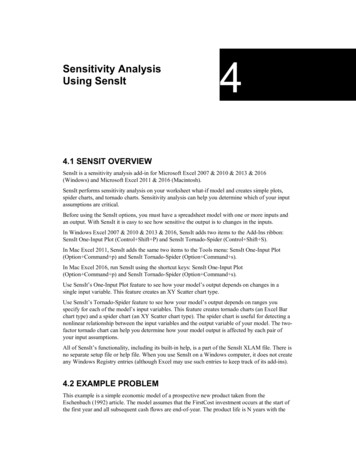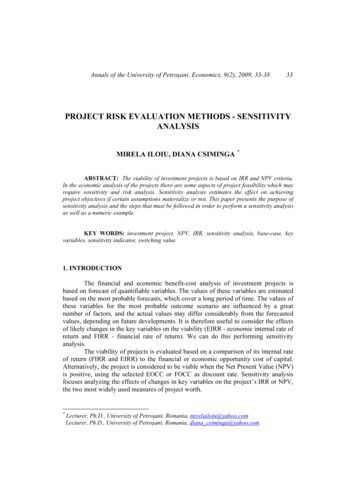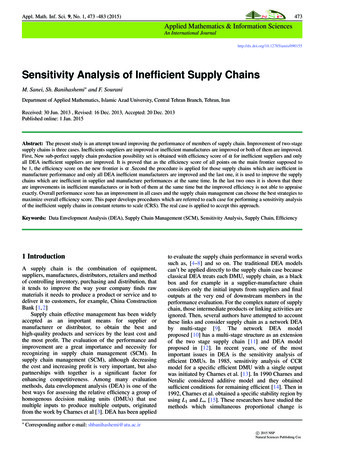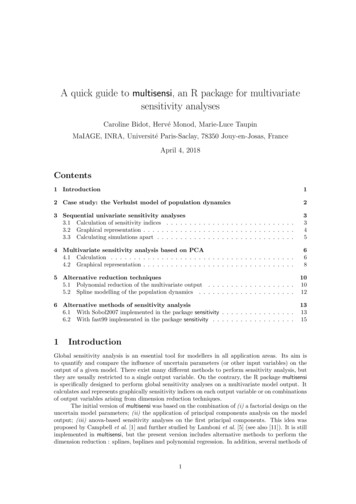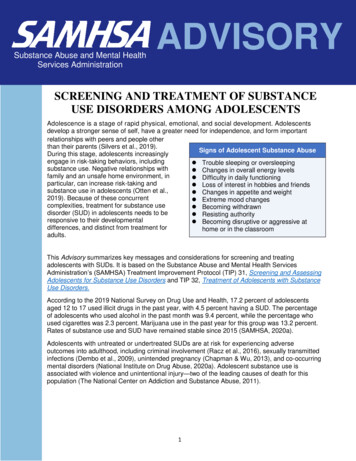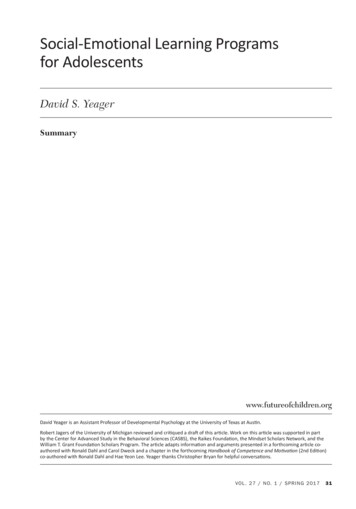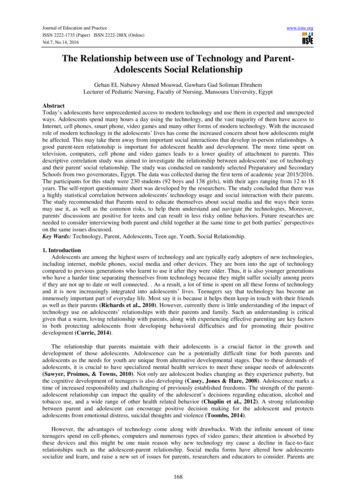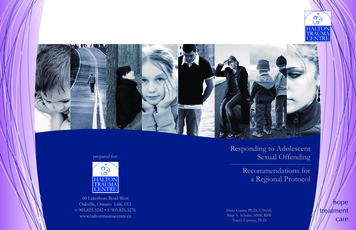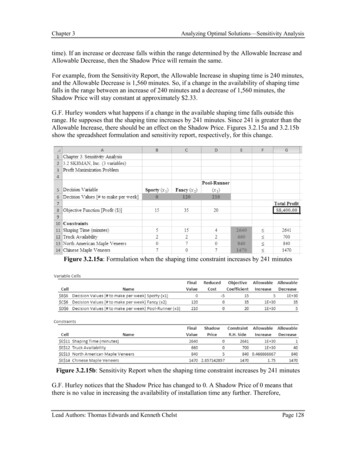
Transcription
Psicothema 2018, Vol. 30, No. 2, 201-206doi: 10.7334/psicothema2017.193ISSN 0214 - 9915 CODEN PSOTEGCopyright 2018 Psicothemawww.psicothema.comAdolescents’ sensitivity to children’s supernatural thinking:A preparation for parenthood?Carlos Hernández Blasi1 and David F. Bjorklund21Universitat Jaume I and 2 Florida Atlantic UniversityAbstractBackground: Young children often use magical explanations to accountfor ordinary phenomena (e.g., “The sun’s not out today because it ismad”). We labeled these explanations supernatural thinking. Previousresearch reports that supernatural thinking attributed to preschool-agechildren evokes both positive affect and perceptions of helplessness fromboth adults and older (14-17 years old) but not younger (10-13 years old)adolescents. In this study, we asked if cues of cognitive immaturity aremore influential in affecting adolescents’ judgments of children thanphysical cues (faces). Method: 245 adolescents aged between 10 and 17rated pairs of children who physically and/or cognitively resembled eithera 4- to 7-year-old or an 8- to 10-year-old child in three between-subjectconditions (Consistent, Inconsistent, Faces-Only) for 14 traits classifiedinto four trait dimensions (Positive Affect, Negative Affect, Intelligence,Helplessness). Results: For both younger and older adolescents, cognitivecues had a greater influence on judgments than facial cues. However, onlythe older adolescents demonstrated a positive bias for children expressingimmature supernatural thinking. Conclusions: Adopting an evolutionarydevelopmental perspective, we interpreted this outcome in late (but notearly) adolescence as preparation for potential parenthood.Keywords: Cognitive immaturity, adolescence, parenthood, evolutionarydevelopmental psychology.ResumenReceptividad de los adolescentes al pensamiento sobrenatural delos niños: ¿una preparación para la paternidad? Antecedentes: losniños pequeños emplean a menudo explicaciones mágicas para referirsea fenómenos cotidianos (por ejemplo, “El sol no sale hoy porque estáenfadado”). Nosotros etiquetamos estas explicaciones como pensamientosobrenatural. Investigaciones anteriores muestran que el pensamientosobrenatural atribuido a niños en edad preescolar evoca afecto positivoy percepción de desamparo en adultos y adolescentes mayores (14-17años) pero no en adolescentes jóvenes (10-13 años). En este estudio nospreguntamos si las señales de inmadurez cognitiva son más influyentesen los juicios de los adolescentes que las señales físicas (caras). Método:245 adolescentes de 10 a 17 años evaluaron pares de niños que emulabanfísicamente y/o cognitivamente a niños de 4 a 7 años o niños de 8 a 10años en tres condiciones (Consistente, Inconsistente, Solo-Caras) respectoa 14 rasgos clasificados en cuatro dimensiones (Afecto Positivo, AfectoNegativo, Inteligencia, Desamparo). Resultados: tanto en adolescentesjóvenes como en mayores, las señales cognitivas tuvieron mayor influenciaque las señales faciales. Sin embargo, solo los adolescentes mayoresmostraron un sesgo positivo hacia niños que expresaban pensamientossobrenaturales. Conclusión: adoptando una perspectiva evolucionistadel desarrollo, interpretamos este resultado en la adolescencia tardía (notemprana) como preparación para la paternidad.Palabras clave: inmadurez cognitiva, adolescencia, paternidad, psicologíaevolucionista del desarrollo.Humans are unique among mammals in a number of ways. Oneof the more distinctive human features is their prolonged period ofimmaturity and dependence on others before reaching a sufficientcompetence for survival. In fact, in all human societies parentsmust provide their offspring with food and care for about a decade,if not more (Bogin, 1994).Typically in traditional societies “the problem of child care”has been solved by the use of alloparents, people other than thegenetic parents who provide care for children (Lancy, 2015). OneReceived: May 25, 2017 Accepted: January 22, 2018Corresponding author: Carlos Hernández BlasiFacultad de Ciencias de la SaludUniversitat Jaume I12071 Castellón (Spain)e-mail: blasi@uji.esparticularly important class of alloparents is adolescents. Forexample, Bogin (1994) reports that in different types of traditionalsocieties (hunter/gatherers, horticulturalists) adolescence is a timewhen parenting skills are learned and practiced before reproductiontakes place. Bogin argued that the significant differences foundin the rates of offspring survival until adulthood among humantraditional societies, chimpanzees, and social carnivores suchlions (50%, 35%, and 12% respectively), as well as between firstborn and next born in other species (e.g., Altmann, 1980), supportsthe hypothesis that adolescence in humans evolved to provideindividuals with the time required to acquire the complex socialskills needed to become competent parents.Goetz, Keltner, and Simon-Thomas (2010) proposed that toguarantee the care needed for the survival of vulnerable offspring,several adaptations were shaped over our species’ evolutionaryhistory: (a) an effective response to neotenous cues and distress201
Carlos Hernández Blasi and David F. Bjorklundvocalizations; (b) specific tactile behaviors such as skin-to-skincontact; (c) attachment-related behaviors; and (d) the possibilityto experience compassionate emotion. In this context, offsprings’signals providing cues to adults regarding their maturity, health,and the degree of urgency of their needs, along with adults’positive attitude toward the children emitting these signals,become important. These cues can be physical (e.g., facial featuresdescribed by Lorenz, 1943), behavioral (e.g., clumsy movements,smiling, Bowlby, 1969), or vocal (e.g., infants’ crying as cues tohealth, Soltis, 2004).In recent years, we and our colleagues have investigated theeffects on adults’ and adolescents’ judgments of children forcues of cognitive immaturity, analogous to the cues of physicalimmaturity originally proposed by Lorenz (Bjorklund, HernándezBlasi, & Periss, 2010; Hernández Blasi, Bjorklund, & Ruiz Soler,2015, 2017; Periss, Hernández Blasi, & Bjorklund, 2012). Morespecifically, we have investigated the influence that some children’sverbalized immature explanations of ordinary phenomena (e.g.,why clouds block the sun; why some mountain have big andsmall peaks) have on adults’ and adolescents’ perception of them.We have found that some forms of immature cognition, such asthose described by Piaget (1926) typifying the preoperationalperiod (e.g., animism, “The sun’s not out today because it’s mad”;finalism, “The big peak is for long walks, and the small peakis for short walks”), have positive effects on adults’ and olderadolescents’ (14 to 17 years old) perception of children, but not onyounger adolescents (10 to 13 years old). In contrast, other forms ofimmature cognition (e.g., overestimating one’s performance, “I canremember all 20 words!”; having difficulty inhibiting responses,“I couldn’t avoid peeking in the box!”), had negative effects onadults’ and both younger and older adolescents’ judgments of thechildren professing them. We labeled the former type of immaturecognition supernatural thinking (because it seems to share asupernatural or magical explanation of a natural phenomenon),and the latter type of immature cognition natural thinking. Wehave also found that the effects of children’s supernatural thinkingon adults’ judgments prevail over the effect of facial cues whenpresented together (Hernández Blasi et al., 2015, 2017).We suggested (Bjorklund et al., 2010; Periss et al., 2012) that thereason why children’s immature supernatural thinking provokespositive reactions (and immature natural thinking does not) mighthave to do with the fact that some forms of magical causation involvedin this type of thinking are characteristic of adults (see Subbotsky,2014), increasing sympathy and/or empathy toward children whoverbalize them. In contrast, immature natural thinking is perceivedby adults as a “cognitive error” or mistakes, and therefore is notseen as something endearing in children, provoking negative affect.Moreover, the fact that this pattern is found in older but not youngeradolescents is consistent with the preparation of older adolescentsfor their near future potential role as parents.One unexplored issue is adolescents’ reactions to youngchildren’s supernatural thinking when simultaneously presentedwith physical-appearance cues, i.e., faces. Although one mightexpect adolescents to display the same pattern as adults (i.e.,cognitive cues prevailing over physical cues), such a conclusionmay not be warranted. For instance, some research (Fullard &Reiling, 1976) reports that the first significant bias towards “babylike” faces begins in early adolescence, making tenable that theimpact of physical cues will be stronger than the effect of cognitivecues not only during early but also late adolescence, a reversal of202the adult pattern. Alternatively, if as other research has found (e.g.,Borgi et al., 2014), a positive sensitivity toward “baby-like” facesis already present in childhood, one might expect that the noveltyprovided by cognitive cues would be more informative for youngeradolescents than physical cues in terms of immaturity status,making their reaction in favor of supernatural-thinking cues overphysical cues even stronger than found in adults.The main objective of this study was to determine if theadvantage provided by children’s cognitive over facial cues onadults’ reactions toward children, documented and replicatedfor adults (Hernández Blasi et al., 2015, 2017), is also present inadolescence; and if so, if the effect varies for younger (10 to 13years old) and older (14 to 17 years old) adolescents, consistentwith patterns of judgments for natural and supernatural vignettesreported by Periss et al. (2012). No prediction about sex differenceswas made, given the inconsistencies found in our previous studiesregarding this variable.MethodParticipantsThe sample comprised 245 10- to 17-year-old adolescents,recruited from several public and private schools in Castellón,Spain. They represented a broad range of backgrounds andsocioeconomic levels. We divided participants into two groups:younger adolescents, ages 10 to 13 years (n 115, 51 boys; M 12.0 years, SD 1.3), and older adolescents, ages 14 to 17 years (n 130, 69 boys; M 16.3 years, SD 0.8).InstrumentsThe methodology and questionnaires were based on HernándezBlasi et al. (2015). Questionnaires were booklets composed of fourdouble-sided pages, with a cover page where simple instructions wereprovided, and age, gender, and educational level of the participantwas recorded. In the rest of pages, four pair-comparisons werepresented successively so that, for each pair, participants could seesimultaneously two children’s pictures in high quality resolutionlocated on their left side, and a listing of 14 traits or short statementsabout these children on their right side. Participants were assignedto three between-subjects conditions: Consistent, Inconsistent,and Faces-Only. In the first two conditions, questionnaires werecomposed of four pair-comparisons that included both a vignetteand a photograph of a child’s face. Two of these pairs included avignette attributed to a child expressing immature supernaturalthinking (e.g., animism, “The sun’s not out today because it’s mad”)and a vignette attributed to a child expressing mature cognition(e.g., “The sun’s not out today because clouds are blocking it”). Theother two pairs included vignettes attributed to a child expressingimmature natural thinking (e.g., overestimation, “I can rememberall 20 cards!”) and a vignette expressing a mature version of thesame thought (e.g., “I can remember 6 or 7 cards”).In the Consistent condition (39 younger adolescents, 44 olderadolescents), each immature vignette was matched with a photoof a child’s face manipulated to resemble approximately a 4- to7-year-old child, whereas each mature vignette was matched with aphoto of the same child manipulated to resemble approximately an8- to 10-year-old child. In the Inconsistent condition (37 youngeradolescents, 41 older adolescents), each immature vignette was
Adolescents’ sensitivity to children’s supernatural thinking: A preparation for parenthood?matched with the photo of the mature child’s face, whereas eachmature vignette was matched with the photo of the immaturechild’s face. In the Faces-Only condition (39 younger adolescents,45 older adolescents), only immature vs. mature photographs ofthe same child were depicted. For each participant, two of thepairs were boys and two were girls. The procedure for morphingand selecting the photos of the children are described in detail inHernández Blasi et al. (2015).For every pair-comparison in each condition, adolescentsdecided which of the two children illustrated better a series of14 traits, reflecting a wide range of characteristics potentiallyrelevant in interactions with young children. Based on principalcomponent analyses of our previous studies for Spanish samples(Hernández Blasi et al., 2017; Periss et al., 2012), we organizedthese traits into four main groups: Positive Affect (Cute, Friendly,Nice, Likeable), Negative Affect (Sneaky, Likely to lie, Feelmore angry with, Feel more irritated with), Intelligence (Smart,Intelligent), and Helpless (Helpless, Feel more protective towards,Feel like helping). (The item Curious did not load highly on anyfactor and was not included in subsequent analyses).Data analysisParticipants’ choices were coded as 1 when they selected thechild represented by the immature vignettes and 0 when theyselected the child represented by the mature vignettes. In theFaces-Only condition responses were coded as 1 when participantsselected the immature face and 0 when they selected the matureface. Thus, mean scores greater than 0.5 indicate that participantsselected the immature vignettes (in the Faces Vignettes conditions)or the immature faces (in the Faces-Only condition) more often,whereas scores less than 0.5 indicate that participants selected themature vignettes (in the Faces Vignettes conditions) or the maturefaces (in the Faces-Only condition) more often. Initial analyses(two-tailed, single-sample t tests) indicated whether immature ormature children were selected significantly different than expectedby chance (.50) for each age trait condition vignette-typecell (p .05, adjusted for multiple contrasts). To assess furtherthe pattern for the various age groups, conditions, and traits, wecomputed a series of ANOVAs, first for the Faces-Only condition,and then for contrasting patterns between the Consistent andInconsistent conditions.ProcedureResultsQuestionnaires were administered in small groups in quietrooms by school personnel under researchers’ supervision andwith both the parents’ and adolescents’ consent. The differentquestionnaire versions of each condition were assigned at randomto the participants.Table 1 presents the mean scores by age (Younger Adolescents,Older Adolescents), trait dimension (Positive Affect, NegativeAffect, Intelligence, Helpless), and condition (Consistent,Inconsistent, Faces-Only), separately for Supernatural and NaturalTable 1Proportion of participants selecting the immature face (Faces-Only condition) or the child expressing immature cognition (other conditions) by trait dimension,condition, vignette type, and age group (standard deviations in parenthesis)Positive affectSuperNaturalNaturalNegative aturalHelplessSuperNaturalNaturalFaces-Only(n 39)Younger adolescents(10-13 years).67a (.15).44 (.29).50 (.31).44 (.26)(n 45)Older adolescents(14-17 years).66a (.21).55 (.26).49 (.23).43 (.26).57 (.26).51 (.26).47 (.29)a.68 (.21)(n 66)Adults (Hernández Blasi et al., 2015)Consistent(n 39)Younger adolescents(10-13 years).58 (.29).57 (.21).65a (.27).57 (.22).13b (.24).36b (.22).67a (.29).49 (.24)(n 44)Older adolescents(14-17 years).71a (.24).43 (.26).54 (.32).77a (.22).10b (.20).35b (.31).76a (.26).46 (.27)aaba(n 60)Adults (Hernández Blasi et al., 2015).72 (.27).43 (.25).56 (.29).76 (.22).17 (.27).38 (.32).76 (.31).45 (.30)Inconsistent(n 37)Younger adolescents(10-13 years).44 (.26).26b (.22).65a (.23).73a (.23).14b (.22).33b (.22).67a (.30).55 (.26)(n 41)Older adolescents(14-17 years).62* (.31).31b (.21).46 (.35).63* (.30).10b (.21).37b (.28).85a (.26).52 (.29)(n 55)Adults (Hernández Blasi et al., 2015).59 (.29).31b (.21).48 (.31).72a (.26).17b (.22).29b (.27).79a (.29).53 (.31)Vignettes-Only(n 132)Younger adolescents(10-13 years) (Periss et al., 2012).51 (.29).40b (.29).64a (.30).65a (.32).17b (.25).28b (.41).73a (.30).46b (.35)(n 302)Older adolescents(14-17 years) (Periss et al., 2012).65a (.31).34b (.31).57a (.34).71a (.34).11b (.27).33b (.39).80a (.31).50 (.40)(n 151)1Adults (Bjorklund et al., 2010)a.68 (. 27)b.28 (.24).53 (.28)a.81 (.21)b.11 (.20)b.36 (.34)a.77 (.24).28b (.26)Note: a selecting an immature child significantly greater than expected by chance; b selecting a mature child significantly greater than expected by chance; p .000-.006,excepting for *, where respectively p .02 and .01; p .002, for Bjorklund et al. (2010) and Periss et al. (2012); p .001, for Hernández Blasi et al. (2015); 1Data organizedon the basis of a different factor analyses from Bjorklund et al. (2010) (see note in Hernández Blasi et al., 2015, p. 519)203
Carlos Hernández Blasi and David F. Bjorklundvignette-types. Table 1 also presents mean values for Spanishadult samples from both Bjorklund et al. (2010) and HernándezBlasi et al. (2015), and the Spanish adolescent sample from Perisset al. (2012).Faces-Only ConditionBoth younger and older adolescents selected the immaturechild significantly greater than chance for the Positive-Affecttrait dimension and exhibited no bias towards either child for theNegative-Affect, Intelligence, and Helpless traits.Consistent and Inconsistent ConditionsSupernatural vignettes. For both the Consistent and Inconsistentconditions, older adolescents selected the immature child morefrequently for the Positive-Affect trait and showed no bias towardseither the mature or immature child for the Negative-Affect trait.Conversely, younger adolescents selected the immature childmore often for the Negative-Affect trait and showed no bias forthe Positive-Affect trait. For the Intelligence and Helpless traits,both groups selected significantly more often the mature child forIntelligence and the immature child for the Helpless trait.Natural vignettes. For the Inconsistent condition, both theyounger and older adolescents performed comparably on thePositive-Affect and the Negative-Affect dimensions, with subjectsselecting more often the mature child for Positive-Affect itemsand the immature child for Negative-Affect items. In contrast, inthe Consistent condition both the younger and older adolescentsfailed to exhibit a bias towards either the mature or immaturechild on the Positive-Affect trait. For the Negative-Affect trait inthe Consistent condition, older adolescents selected more often theimmature child, but younger adolescents showed no bias towardseither the mature or immature ,andFaces-Only(Negative Affect, M .63 Helpless, M .62 Positive Affect,M .49 Intelligence, M .23), Vignette type, F(1,140) 9.96,p .002, ηp2 .07 (Supernatural, M .50 Natural, M .48),Condition, F(1,140) 7.50, p .007, ηp2 .05 (Consistent, M .51 Inconsistent, M .48), and the following significant interactions:Trait Vignette type, F(2.55,356.46) 58.30, p .000, ηp2 .29;Trait Condition, F(2.55,356.94) 6.65, p .001, ηp2 .05;Gender of participant Age, F(1,140) 5.22, p .024, ηp2 .04;Trait Vignette type Age, F(2.55,356.46) 8.86, p .000, ηp2 .06; and Trait Condition Age, F(2.55,356.95) 3.92, p .013,ηp2 .03.Subsequent inspection of these interactions revealedthree noticeable differences between the performance of theyounger and older adolescents: (1) there was a slight effectof Gender of participant on global performance for youngeradolescents, with females selecting the vignettes associatedwith the immature child more often than males (Females, M .51 Males, M .41, p .004), but not for older adolescents(Males, M .50 Females, M .49); (2) whereas there were nodifferences for the Consistent condition between younger andolder adolescents’ performance on any dimension (collapsedover vignettes type), there were differences for the Inconsistentcondition, namely on Positive-Affect (Older Adolescents, M .46 Younger Adolescents, M .35, p .018), and NegativeAffect (Younger Adolescents, M .70 Older Adolescents, M .55, p .003) dimensions, but not on the Intelligence andHelpless dimensions; and (3) for the Supernatural vignettesthere were significant differences between younger and olderadolescents (collapsed across the Consistent and Inconsistentconditions) for the Positive-Affect (Older Adolescents, M .66 Younger Adolescents, M .51, p .001), NegativeAffect (Younger Adolescents, M .65 Older Adolescents, M .50, p .002), and Helpless (Older Adolescents, M .80 Younger Adolescents, M .67, p .004) dimensions, but notfor the Intelligence dimension. There were no significant agedifferences for the Natural vignettes.DiscussionA 2 (age) 2 (gender of participant) 2 (photo gender) 4 (trait)ANOVA for the Faces-Only condition, with repeated measures onthe Photo gender and Trait factors, produced a significant maineffect for Trait, F(2.56,189.37) 9.39, p .000, ηp2 .11 (PositiveAffect, M .67 Negative Affect, M .50 Intelligence, M .49 Helpless, M .44), and Photo gender, F(1,74) 9.25, p .003, ηp2 .11 (Photos of Boys, M .54 Photos of Girls,M .50), as well as a significant Trait Photo gender interaction,F(2.49,184.53) 6.98, p .000, ηp2 .09, and a significant Trait Gender of participant interaction, F(3,74) 4.25, p .006, ηp2 .05.Subsequent inspection of these interactions indicated a significantPhoto gender effect on the Positive-Affect (Photos of Boys, M .73 Photos of Girls, M .60, p .000) and Intelligence (Photosof Boys, M .57 Photos of Girls, M .43, p .000), but noton the Negative-Affect and Helpless traits. A significant effect ofGender of participant was found on the Intelligence dimension(Males, M .57 Females, M .41, p .004).For the Consistent and Inconsistent conditions, a 2 (age) 2 (condition) 2 (gender of participant) 2 (vignette type) 4 (trait) ANOVA, with repeated measures on vignette type andtrait was performed. The analysis produced a significant maineffect for Trait, F(2.55, 356.94) 103.78, p .000, ηp2 .43204There were two major findings from our study: First,hypothetical children’s cognitive cues had an overall greater impacton adolescents’ judgments than facial cues. Namely, in 13 of the 16outcomes, scores in the Consistent and the Inconsistent conditionswere comparable and equivalent to those found by Periss et al.(2012) in a Vignettes-Only condition, for the same two age groupsof adolescents studied here (see Table 1). This is quite likely themost noteworthy finding in this study, because it highlights againthe dominance of children’s cognitive cues over physical cues indetermining humans’ (this time adolescents’) reactions toward thepreschool-age children emitting them.Second, we found a developmental pattern similar to thatreported by Periss et al. (2012), with older adolescents displayingthe typical adult patterns for both the Natural and Supernaturalvignettes, whereas the younger adolescents showed a differentpattern. For the Supernatural vignettes, younger adolescentsdisplayed a negative-affect bias toward the immature children andno bias toward either the mature or immature children for PositiveAffect. In contrast, older adolescents replicated the adult patternreported in Bjorklund et al. (2010) and Hernández Blasi et al. (2015),specifically a positive-affect bias toward the immature children and
Adolescents’ sensitivity to children’s supernatural thinking: A preparation for parenthood?no bias toward either the mature or immature children for negativeaffect items. For the Natural vignettes, there were some differencesbetween conditions. Participants in the Inconsistent conditionproduced mainly the same pattern found for the Vignettes-Onlycondition in Periss et al. (2012), with both younger and olderadolescents exhibiting a positive-affect bias towards the maturechildren and a negative-affect bias towards the immature children.Participants in the Consistent condition exhibited a differentpattern, with both younger and older adolescents showing nopositive-affect bias toward either the mature or immature children,whereas older adolescents exhibited a negative-affect bias towardsthe immature child, but younger adolescents showed no negativeaffect bias towards either the mature or immature children. Thedifference in positivity bias for immature supernatural thinkingand the negativity bias for immature natural thinking betweenthe younger and older adolescents can be seen in Figure 1, whichshows the average difference between Positive- and NegativeAffect scores. Results from adults from Hernández Blasi et al.(2015) are shown for comparison purposes.a) Supernatural thinking0,260,130-0,13-0,26YoungeradolescentsOlder adolescentsAdultsb) Natural thinking0-0,13-0,25-0,38-0,5Younger adolescentsOlder adolescentsConsistentAdultsInconsistentFigure 1. Mean difference between Positive-Affect and Negative-Affectscores for supernatural (a) and natural thinking (b) vignettes dependingon whether they were or were not consistently matched with mature/immature children’s faces. Positive values indicate greater positive thannegative affect (bias toward immature thinking); negative values indicategreater negative than positive affect (bias toward mature thinking). Adultdata from Hernández Blasi et al. (2015)This differential pattern between conditions suggests, first, thatthe addition of an inconsistently matched child’s face to a vignettereflecting natural cognition had no additional effect on adolescents’reactions towards children, with participants apparently payingmore attention to the cognitive cues than to the contradictoryphysical cues that were simultaneously presented. Second, thepattern of results suggests that the addition of a consistently matchedchild’s face to a vignette reflecting natural cognition does have aninteraction effect on adolescents’ reactions, apparently reducinga negative-affect bias during early adolescence toward childrenwho verbalize immature cognition, as well as reducing a positiveaffect bias during both early and later adolescence towards maturechildren who verbalize cognitively competent cognition. This isthe first evidence in our studies of an interaction between cognitiveand physical cues, suggesting that, at least regarding naturalthinking during early adolescence, children are actually judgedas a whole, with physical cues modulating the effects typicallyobtained when only cognitive cues are available. We currently donot have a satisfactory explanation for this finding, either from adevelopmental or an evolutionary perspective, making it worthy ofreplication and further study.How might one explain the differential reaction of older versusyounger adolescents regarding the supernatural immaturity cuesfound in this study? One possibility is that supernatural immaturereasoning evolved (jointly with other cognitive or/and noncognitive cues not yet identified) to be a particularly significantcue of children’s maturational status for older adolescentsand adults, given their potential role as a parents and/or closecaretakers, compared to younger adolescents (Periss et al., 2012).During early childhood language presumably becomes a moredistinctive, powerful, and functionally efficient way for childrento convey critical information about themselves to their potentialcaregivers (albeit often implicitly), in comparison to both physicalappearance and vocal cues, which are much more salient andinformative during infancy. This interpretation is consistentwith some theories within evolutionary biology (e.g., Dawkins &Guilford, 1991) that stress the importance that proper signalingbetween and within species has for survival and development.The feasibility of this interpretation should be grounded onfurther research providing convergent evidence. We do not haveyet data available, for example, about the sensitivity of bothchildren younger than the ones studied here and adults in thepost-childbearing years towards young children’s supernaturalthinking, nor about how this sensitivity to young children’ssupernatural thinking cues varies depending on the timing atpuberty, and hence the real possibility of becoming a parent. Inabsence of further research, this interpretation remains speculative,with other potential explanations to our data open. For example,younger adolescences might have identified themselves as closerin cognitive terms to children verbalizing mature thinking, andtherefore perceived as more negative those immature childrenwhom they do not resemble anymore, but still are not so removedfrom them, developmentally speaking, at least in contrast to olderadolescents.No developmental trend was found on the effects of viewingchildren’s faces on either the younger or older adolescents’ reactions.In the Faces-Only condition, both groups of adolescents reactedsimilarly when only faces were provided, namely, the immaturefaces produced significantly higher ratings for the Positive-Affectitems, whereas there was no bias demonstrated towards either205
Carlos Hernández Blasi and David F. Bjorklundchild for the Negative-Affect, Intelligence, or Helpless dimensions.These resul
recruited from several public and private schools in Castellón, Spain. They represented a broad range of backgrounds and socioeconomic levels. We divided participants into two groups: younger adolescents, ages 10 to 13 years (n 115, 51 boys; M 12.0 years, SD 1.3), and older adolescents, ages 14 to 17 years (n

